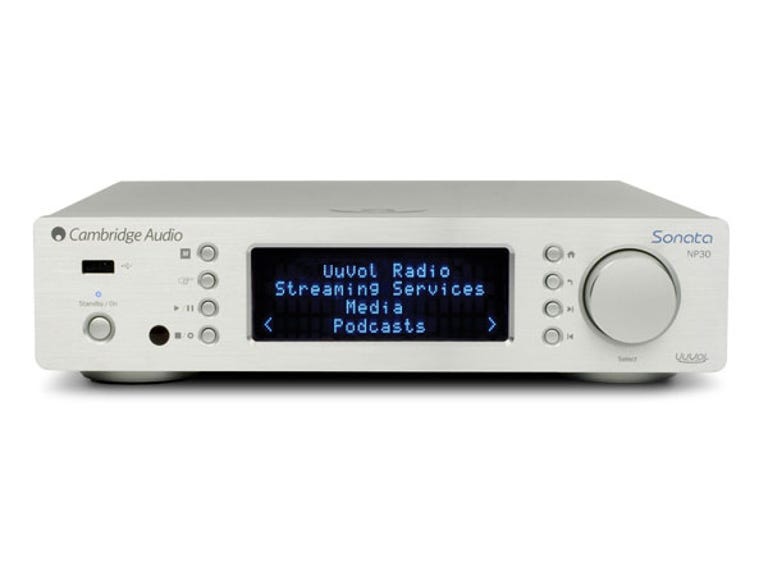 Why You Can Trust CNET
Why You Can Trust CNET Cambridge Audio NP30 review: Cambridge Audio NP30
The Cambridge Audio NP30 is a herald of the future of streaming media with wide format support and decent quality sound.
In the next couple of years, CD and DVD players will be where turntables are now: in a cupboard or fronting the systems of the only most hardened audio/video nuts. Streaming is where things are going, and components that facilitate this are slowly becoming more affordable.
The Good
The Bad
The Bottom Line
The Cambridge Audio NP30 is the latest product to hit the market and the closest to fulfilling all of our "wish-list" features yet.
Design and features
The Cambridge Audio NP30 is part of the Sonata range and is a "half-sized" component at just 270mm wide, 67mm high and 285mm deep. The front of the NP30 features a large, four-line screen controlled by a plastic jog wheel. The screen is a bright blue LED, which, despite a brightness control on the remote, doesn't offer enough contrast for intelligibility across a room.
The NP30 is a media streamer, and its most significant feature is its ability to natively playback high-resolution 24-bit/96kHz audio files. These include both FLAC and WAV files, and it's something that the competing Sonos architecture cannot do. Other file types include WMA, MP3, AAC, Ogg Vorbis and AIFF.
While we found it straightforward to use the controls on the face of the unit, the Cambridge really comes into its own when combined with the UuVol app. This free app enables you to surf internet radio stations, listen to streaming content from the web or locally, and even make playlists.
Given Cambridge Audio's hi-fi reputation, the NP30 comes preloaded with a decent digital analog converter in the Wolfson WM8728 24-bit/96kHz, which enables it to process the high-definition files.
Connectivity includes stereo RCA, digital coaxial and optical, two USB, Ethernet and wireless. Cambridge Audio suggests using an Ethernet cable if you want to use 24-bit files, though. Unfortunately, there's no AirPlay support.
Performance
As with most of these streaming devices, 75 per cent of the experience is tied to how good the control application is. Sonos' is very good indeed, and it's seamless across a raft of devices including PC and Mac. Unfortunately, the Cambridge Audio is currently limited to iPod and iPad, so it misses out on the flexibility of desktop control. While you could use Windows Media Player 12 and the "Play To" command, or indeed another DLNA program, to navigate the NP30, we found this very flaky and likely to not work at all.
The UuVol app is quite good, though, and the iPad version in particular gives you plenty of control. However, it's a little slow to cache all of your music in comparison to apps from Naim and Sonos. It's also quite bad at multitasking, and if you switch back and forth to the app it searches for the unit and rebuilds your music library each time.
The app is logically arranged and building playlists and choosing music to play is straightforward, but if you don't like using it for some reason there's always the option of controlling your media via the unit itself. If you want to playlist tracks with the jog wheel simply hold it down.
We listened to a variety of different music through the NP30, and found it favoured vocally-led music most of all. Voices sound natural, and the device featured an excellent soundstage with a convincing spread across the speakers. Even streamed internet radio found a compassionate ear in the Cambridge Audio. If you like heavier stuff then you may want to look at other alternatives as we discovered that bass could be a little indistinct when using the analog outs.
If you own a stand-alone DAC such as the matching DacMagic, though, you'll find it makes a formidable pairing with the NP30. Music through the DacMagic firmed up significantly, losing a lot of "hash" and glassiness and tightening up the bottom end. It's definitely worth investing a little more in a DAC as the improvements in sound quality are enjoyably palpable.
Conclusion
If it wasn't for the spectre of Sonos, the Cambridge Audio would have this in the bag. It's an easy unit to use, and its ability to play high-res files is unequalled at this price. It also sounds great when used with an external DAC.
But, if you're looking for something more "fun" and more flexible, we'd suggest either the cheaper Sonos Play:3 system or the high-end Naim system; both of which give you the ability to control the volume and input as well.


